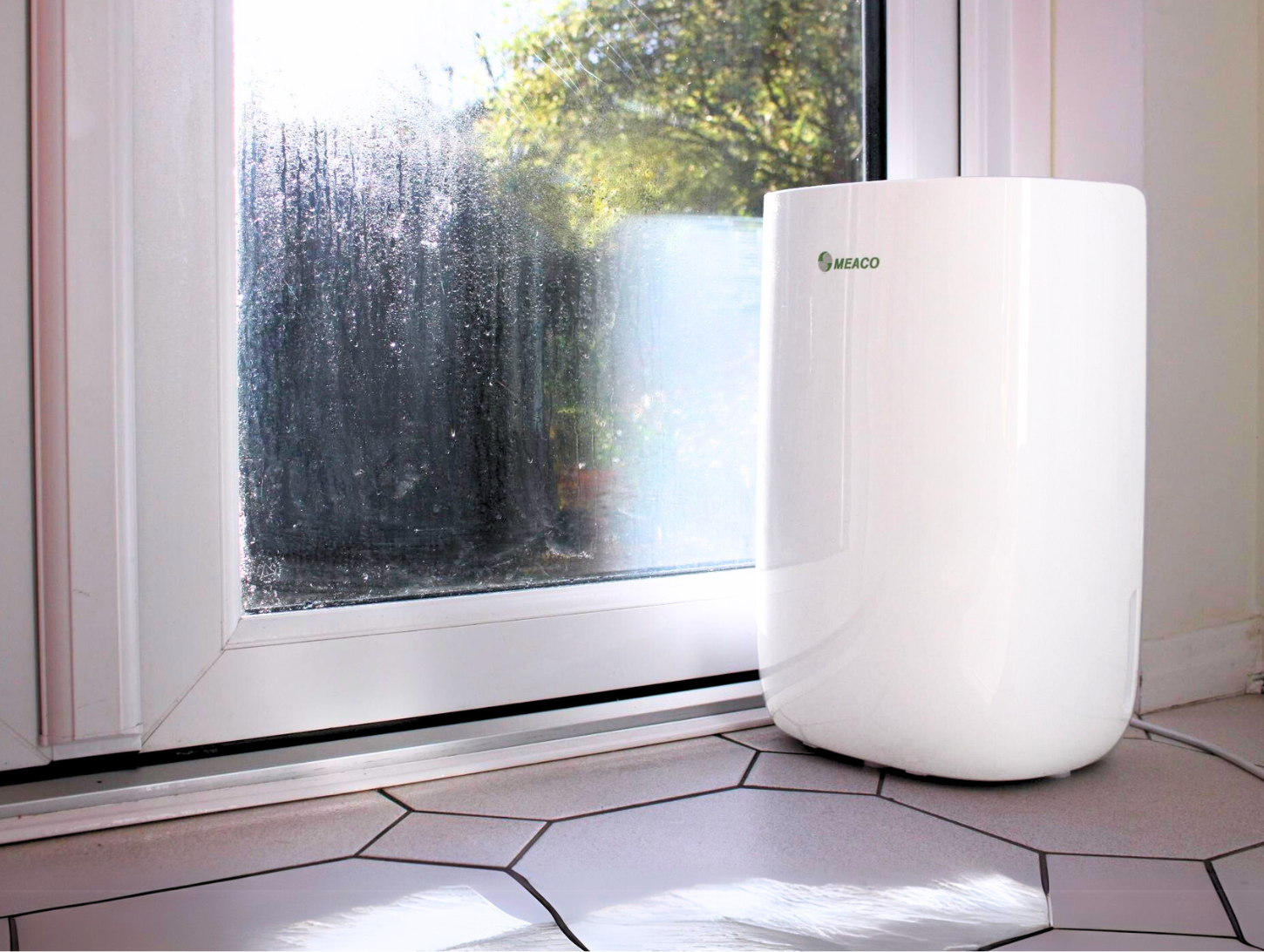
With the cold, there’s also condensation. When the temperature drops outside, generally below 5°C overnight, you’ll start seeing condensation on your windows. You may notice this most in the bedroom, kitchen, bathroom or conservatory, especially early in the morning. Stopping condensation is one of the biggest problems homeowners face.
So, how can you stop condensation? The two main approaches to ‘curing’ or ‘stopping’ condensation are either to open the windows or use a dehumidifier. Open the windows may give pretty instant results but we’re letting in the cold air and then paying to heat it back up. Dehumidifiers provide a fast, effective and cost-efficient way to manage condensation.
Opening windows to deal with condensation
You would probably expect me to recommend that you buy a dehumidifier. I am a dehumidifier manufacturer after all. But let’s look at the benefits of opening windows first.
In Germany, they call it “Stoßlüften”, meaning “shock ventilation” and they may have the right idea about things… When people worry about condensation or mould problems, the advice will often be to open the window. This is to improve ventilation.
However, in some older properties that are often quite ‘leaky’, we can see that condensation is rarely an issue. I mean that in properties with older windows, we don’t always see more condensation. These windows might let in some moisture and may not be fully draft-proof. However, condensation is about trapped moisture inside the house, not extra moisture coming in.
Opening windows can cure condensation – but do you want to let the cold in?
So why does ventilation help? Opening windows can stop condensation – but do you want to let the cold in?
First, what causes condensation on windows?
Essentially, condensation occurs when air meets a cold surface and forms water on that surface. And it’s all about the relationship between relative humidity and temperature. In most cases, the surface is the cold glass panes of your windows and the relative humidity is moisture within your home. It doesn’t matter how little moisture there is in the air – if the surface is cold enough, you will get condensation.
Your windows provide the perfect cold surface because they are in direct contact with the chilly outside. If you touch the window pane, you’ll feel the difference!
This is why my windows at home have been free of condensation for months. Now the temperature has dropped, I can suddenly see condensation. I doubt that the amount of moisture in the air in my home has increased. It is just that the surface temperature of the window is lower during a cold spell.
This is also why you’ll find double-glazed windows usually have less condensation than single-glazed ones. This is because the two panes form an insulated barrier. And as a result, the inside pane isn’t quite as cold and condensation is less likely to occur. Remember that double-glazing condensation can still happen, it’s just less frequent than single glazing. This does not mean your windows are broken but there are steps you can take to reduce it.
What is the science behind condensation: the relationship between humidity and temperature?
Condensation forming on cold surfaces happens because of the inverse relationship between temperature and relative humidity. As temperature falls, relative humidity increases and as temperatures increase, relative humidity falls. So if you heat air up, the relative humidity will decrease. This is the key to the reason why ventilation can help cure condensation.
So, there are two things helping to form condensation, the temperature of a cold surface (your windows) and relative humidity. Of these, which can we control in order to stop condensation?
Unless you have fancy heated windows, then the answer is relative humidity. You can do this in a few ways. Let’s start with opening the window.
Does opening the window stop condensation?
Ultimately, yes. You’ll quickly notice the condensation leaving the windows. The air in your home is full of moisture from cooking, bathing, showering, drying washing and even breathing. The air outside in winter will probably have a lower relative humidity. So when you open the windows, warm, damp air goes out and cold air comes in.
Condensation can build up easily on any cold surface, especially windows throughout winter.
But now your room is a lot colder and you don’t know whether the outside air has changed your room’s relative humidity.
Have we helped to reduce the condensation situation? The answer is still yes. If you’re having a hot shower and open the window a smidge, you can watch the condensation reduce dramatically.
It is also because we are not going to let the air stay cold. We will heat it up to a temperature that we are comfortable with.
Even if the air outside is freezing, I still want it to be about 20°C in my house but I’ve opened the window and let some of that cold air in. I will warm it up and I’ll turn the heating on.
And in the laws of science, increased temperature means decreased relative humidity. If we assume the incoming air is full of moisture, warming it up will reduce that relative humidity as well. Let’s say the incoming air has a relative humidity around 90%rh, increasing the temperature will reduce it down to something like 25%rh.
So, all is good! We have got rid of our warm damp air, replaced it with cold damp air and warmed it up. We now have warm dry air. There’s a cure for condensation.
Opening the windows will work and is an effective solution to condensation control.
But..
Think about what we have just done. We have heated the air, costing us money, and then we have thrown that heated air out of the window. It might have been easier to throw fivers into the street!
To replace it, we have introduced freezing cold air into our home and made ourselves feel very uncomfortable.
Now, we need to warm the cold air. This will help us feel comfortable again and lower the humidity. This costs more money in energy, and later in the day, we’ll have to do it all over again. In fact, ideally you will have to do this in every room in the house. You will certainly need to do it in the bathroom, kitchen and bedrooms at the very least.
Opening the windows does work but I am not a fan because of two reasons. One, it makes people feel uncomfortable. Secondly, there’s a huge hidden cost of reheating the fresh air coming in from outside. With energy bills skyrocketing it seems a real waste of money to keep on throwing the energy outside.
Is a dehumidifier a better way to stop or prevent condensation?
Yes, a dehumidifier is a superb way to manage relative humidity in your home and reduce condensation. Plus, a dehumidifier is the only way you’ll remove moisture. As we mentioned earlier: condensation occurs because of temperature and relative humidity. You are unlikely to control the temperature of your windows, but you can manage relative humidity with a dehumidifier. Making a dehumidifier an incredibly effective choice to prevent condensation.
Running a dehumidifier does of course have a cost to it. There is an initial price of the unit, and then there’s the electricity cost to run it.
But there is an important difference between the cost of running a dehumidifier and the cost of heating air.
MeacoDry ABC Dehumidifier extracting excess moisture and preventing condensation from occurring
- Some dehumidifiers create a little warmth while dehumidifying. Desiccant dehumidifiers create around 12°C which is ideal especially in garages and conservatories.
- If you’re opening the window and running the central heating, you’re potentially throwing hundreds of pounds away every year. The hot air often escapes through the window. You will just heat it up again later when you open another window.
- Finally, heating dry air is actually a lot cheaper than heating damp air. Read more: 7 Ways to Stay Warm, Save Money, and Delay Turning the Central Heating On
We use our dehumidifiers mainly in the winter when condensation is at its worst. It’s freezing outside which provides the perfect cold surface on your windows to condensate. And we are closing the windows and doors, trapping moisture in our home. This is the perfect recipe for condensation.
In the winter, it is cold and we need to heat our homes. The energy used by the dehumidifier is returned to the room that it is standing. And that energy is in the form of warmer air.
So the cost of running a dehumidifier is retained within your home. If you have a radiator within the same space as the dehumidifier, you can turn it off – helping to keep your energy bills down. So where is the cost of running the dehumidifier if you are benefiting from and enjoying the heat that it generates?
Read more: How much does it cost to run dehumidifier units? Less than you think!
How do deal with condensation in a conservatory
Condensation in conservatories is a hugely common problem for homeowners. It’s a room of windows, creating that perfect cold surface. It’s unheated so we’re not reducing the relative humidity by increasing temperature. And it’s just as likely as the rest of the house to contain moisture.
Both solutions work well for reducing condensation in these spaces: opening windows and running a dehumidifier. But if you want to proactively prevent condensation in a conservatory? My best recommendation is to manage your relative humidity with a desiccant dehumidifier.
Read more: How do I prevent condensation in a conservatory?
A dehumidifier is a fast, effective and cost-efficient way to stop condensation. Opening the windows may seem to be the easy – and free – solution, but it’s not quite as cheap as it looks!
We recommend…
- Compact and stylish dehumidifier
- Quiet Mark – from just 36dB
- Eliminates moisture – ideal for damp, mould and condensation
- Shop now
Meaco Low Energy Dehumidifiers
- Low cost to run – 4p / hour based on 24.50p / kWh
- Quiet Mark Award – up to 41 dB
- Tackles damp, mould and condensation
- Shop now
Meaco DD8L Desiccant Dehumidifier
- Superb at removing condensation from windows
- Desiccant dehumidifier
- Provides additional warmth & offers high performance
- Shop now
Browse all dehumidifiers.

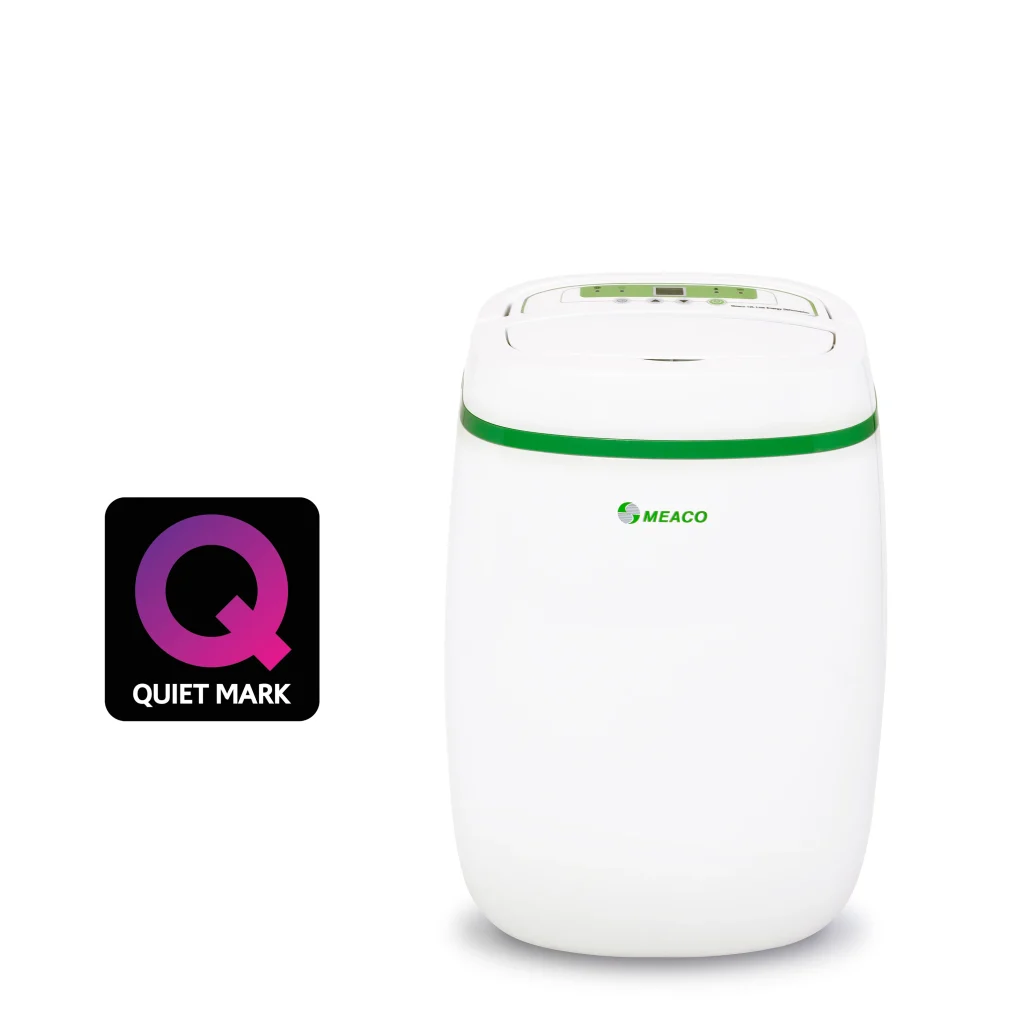
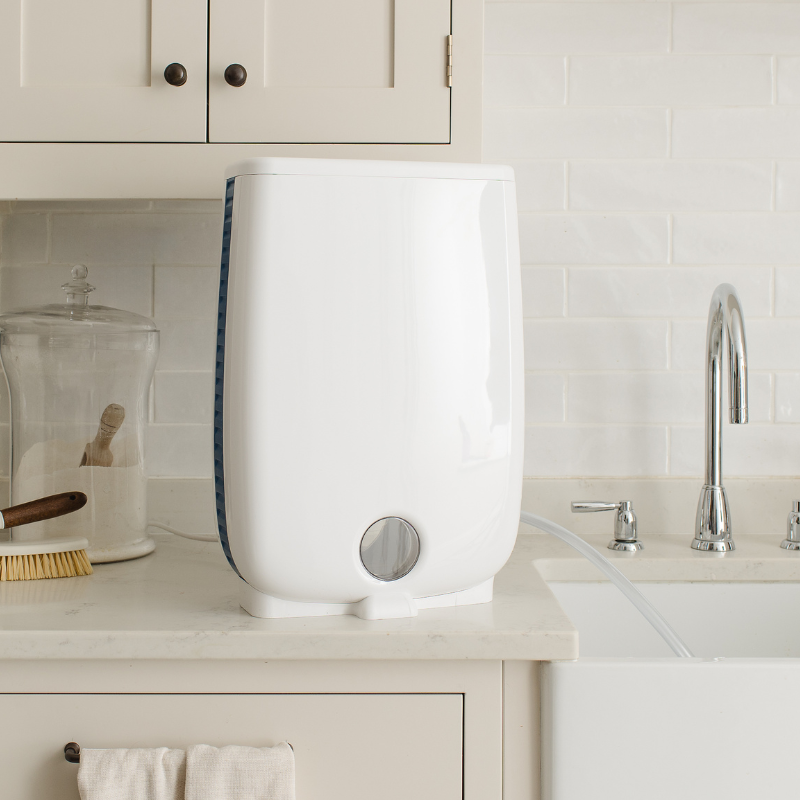






215 responses
Thank you for taking time to explain this complex subject. I live in a 1930s house, which most of the town I live in is comprised of but we all have huge problems with condensation, so I’m not sure that older homes self-ventilate? (It was worse before double glazing.) Our worst-affected room has an air vent, 2 external (double-brick tiny non-fillable cavity) walls but is always freezing cold & this winter has had all manner of mould growing in there which I’m constantly battling with. My lungs are not in good health so this adds urgency to the matter. I’ve been running the dehumidifier but only rarely got the little chap’s face on my hygrometer to smile, which he does at 70% humidity (or below) – do I need to run the dehumidifier all the time, as my husband is not at all keen on the cost of running the unit? We have no idea of the energy cost of running it & don’t have a smart meter. I can’t work out why so much moisture is coming into the room as we cover pans, don’t air clothes in the house, have extractor fans in the kitchen & bathroom etc – I get that there’s an inverse relationship between temperature and humidity, but also why is this the case – where is the extra water vapour in the air coming from? Thanks.
Sounds like you are running a separate hygrometer and are looking at that reading rather than what the dehumidifier says. I don’t know which dehumidifier you, but my advice would be to set the dehumidifier to 50%rh and let it run 24/7/
In terms of running cost the rating label sticker on the side of the machine provides varies bits of information, one of which is wattage, that will give you a guide to consumption and how much it will cost to run.
Hi, this is such an interesting article, thank you. I’ve just bought a small dehumidifyer for my bedroom, which I spend 90% of the day in due to a chronic health condition. My windows are double glazed and I tend to keep the small window open most of the day, even if it’s just a crack open. There’s condensation in the winter (which I now know why thanks to your informative article) and mould builds up. There’s black mould up the side walls next to the window, but my dad painted over it last year before I could treat it!
I’ve placed my dehumidifyer on the window ledge which at night, sits between closed blinds and curtains. I’m so far keeping it on 24/7, but would love some advice on placement of the unit – should it be in the bedroom rather than on the window ledge inbetween curtains and blinds? And does it need to be on all night – it does make a noise and I’m noise-sensitive it disturbs my sleep, but I’m prepared to wear earplugs if needed. Thank you so much 🙂
Helen,
If it can fit on the windowsill then it sounds like a small Peltier dehumidifier, this type extracts very little water from the air so you will have to run it 24/7 to have any chance of success.
Good luck.
Chris
Hi Chris
We have a cupboard at the top of the stairs, the previous owners had converted into a small office and it has a velux window in there but no radiator.
It has been used as storage by us up until now but recently I began working from home and we have cleared it out, decorated etc.
This morning, we are in Scotland, I went into the office. The door had been left slightly ajar with the velux blind down and the walls around the velux were wet!
Do you have any suggestions for dealing with this issue?
Yoda,
For this to happen you need to have excess moisture coming into contact with a cold surface. So you need to get rid of the excess moisture. I would put a dehumidifier on the landing and leave the door to the office space open as much as possible.
Chris
Hi Chris,
My apartment is 60 square metres. I open all windows three times a day to thoroughly ventilate the apartment, as well as opening the bathroom and kitchen windows as necessary. The relative humidity level ranges from about 65-87%. Sometimes opening the windows doesn’t make it go down at all though, but that should change as autumn sets in.
The bedroom has always been much colder than the living room, about 2-3 degrees colder than the living room. There is no musty smell and no mould though. Also, the bedroom windows (which are double-glazed, albeit older ones) have much condensation on them when the weather starts to cool.
I was thinking that a desiccant dehumidifier would be best, since I do dry some laundry in the living, and also because it lets out warmer air, I could save on heating costs. Do you agree that such a dehumidifier would be appropriate and if so, which size?
Thank you for your help
Hayley,
A DD8L desiccant dehumidifier will do that job fine there is no doubt about it. opening windows in summer helps to freshen things up but does not deal with the humidity issue as you have found. In winter this works if the outside air is colder than the inside of the apartment. But of course the drawback is higher heating bills. See how you get on with the DD8L and continue to open windows after bathing and cooking but don’t open them as much to help keep your heat in and let the dehumidifier manage the room humidity.
Chris
Will a humidifier work with shutters? I live in a listed building and have single pane windows – I use the shutters on all the windows at night to keep the heat in, but the windows are running with condensation in the morning as the temperature gets colder. Will a humidifier help, or is using shutters the equivalent of closing a door?
Linda,
I think that you have answered your own question there, it will be better with the shutters open but the combination of using a dehumidifier and having the shutters open for as long as possible during the day will help. But with single glazed windows you will always get some condensation.
Chris
Hi,
Great info on here, very interesting. I have an issue with an unheated conservatory where in the winter the condensation is so bad overnight that its running down the windows and wall underneath becomes moldy. Its now got to be a tradition in the spring to clean it all down so it feels like we can use it again. Its not used at all in the winter although this summer we have actually put some gym equipment in there so it would be nice to be able to use it when it gets colder.
I was toying with putting a panel heater in there to maybe run at a low temp for a few hours a day (maybe overnight when its coldest) as well as one of your Dehumidifiers, the ABC 12L looks good and I could use that in other rooms for clothes drying etc as well.
Do you think this would solved the condensation issue or would the combination of running a panel heater and dehumidifier for a few hours every day work out overly expensive? what sort of temp would the conservatory need to be kept at to help prevent condensation and make a dehumidifier worthwhile? The conservatory is doubleglazed but gets very cold in winter with no heating in there.
Thanks,
Alun
Alun,
This is a very common problem with conservatories because the surface temperature of the glass is so low in winter. Have a think about where the moisture is coming from, are you drying washing in there, does it open onto the kitchen? Certainly exercising in there will create condensation issues.
A combination of a heater for your comfort and a 20l dehumidifier will make the world of difference. Or you could go for a desiccant dehumidifier that will add heat to the same as it dries the air. Either way a dehumidifier and a heater will make the most of your investment in the conservatory and will ensure that you can use the space 12 months of the year.
Chris
Hi,
Is it best to turn dehumidifier off when I have the window open or should I always keep it on?
Thanks
When the windows are open for long periods of time (hours) then turn the dehumidifier off. If you are just opening the windows for a while after showering or cooking then leave the dehumidifier on.
Hi
I live in a 2 bedroomed detached cottage. North facing. We have found black mold on one corners of the upstairs bedrooms. Behind clothes in one corner of one bedroom and behind a trunk in the corner of another bedroom. There was ivy on the cottage walls which has now been removed. The mold is on the side of the house with no windows. I would like to buy a dehumidifier I do not dry clothes and the bathroom window is always a liitle ajar. The walls up the stairs are always cold and my decorater said they felt damp. My cottage is north facing. I have moss on my roof tiles
Best go for one of the 12l models, the Meaco 12L Low Energy would be best because then any mould spores will be caught in the HEPA filter. The other piece of advice would be to make sure that nothing is touching an outside wall, if you always have an air gap you will get less mould.
Have a look on the outside for any cracks that would allow rainwater to get into the brickwork.
Good luck.
Chris
My son has Terrible condensation in his loft half of the loft is dry the other half it’s really wet and it is dripping from the roof onto the insulation and onto the ceiling and down the walls I have been told if he wants to fit a PIV in the loft it should cure the problem do you know anything about these PIV he needs help really bad as he’s got young children and you only get fit in the back of the house and not the front thank you
Roger,
Sorry to hear about the issues, a PIV is not the first port of call here and might not be an answer to any of the problems. Best to check that the insulation is not blocking the roof’s ventilation and to check off all of the steps on this webpage – https://skill-builder.uk/how-to-stop-condensation-in-your-loft-space
Good luck.
Chris
Hi Chris, we are in 2 bed house and get a lot of condensation. The living room gets a bit of mould on the walls and even in the wooden flooring. What dehumidifier would you recommend for us? Also how long do you need to run them for, how many hours a day? Thank you
Chantelle,
Sounds like you have quite an extreme problem here so i would go for a two prong approach. First manage the sources of moisture. Open windows after bathing and cooking, use lids on pans where possible and clean and use all extractor fans. Make sure that you dry the laundry on a clothes horse in the smallest room in the house and run a dehumidifier in laundry mode next to the clothes horse. Place the dehumidifier when not drying laundry somewhere central in the home and let it run 24/7 with the humidistat set to 50%rh.
The best dehumidifier for you will be the MeacoDry Arete 20L. https://www.meaco.com/products/meacodry-arete-one-20l-dehumidifier-and-air-purifier
It is due back in stock in a couple of weeks time and is also available at the moment from Argos for immediate delivery.
Chris
We live in a 4 bed 1930s semi which does get some condensation on the bottom of the windows. However the main bedroom gets really wet windows in winter with some puddles on the window ledge. It is a bay window however the downstairs bay doesn’t have anything like this issue. The bedroom has a small washroom off it (toilet and wash basin only) but the door to it is usually kept closed. What sort of dehumidifier would we need please as we would probably only use it for just this room as rest of the house is ok.
Karen,
Put a MeacoDry ABC 10L in there and let it run either in the bedroom or just outside the ebdroom door. Use the extractor in the washroom or open the window a few times a day. Leave the curtains open as much as possible and leave the washroom and bedroom door open as much as possible.
This will all help.
Chris